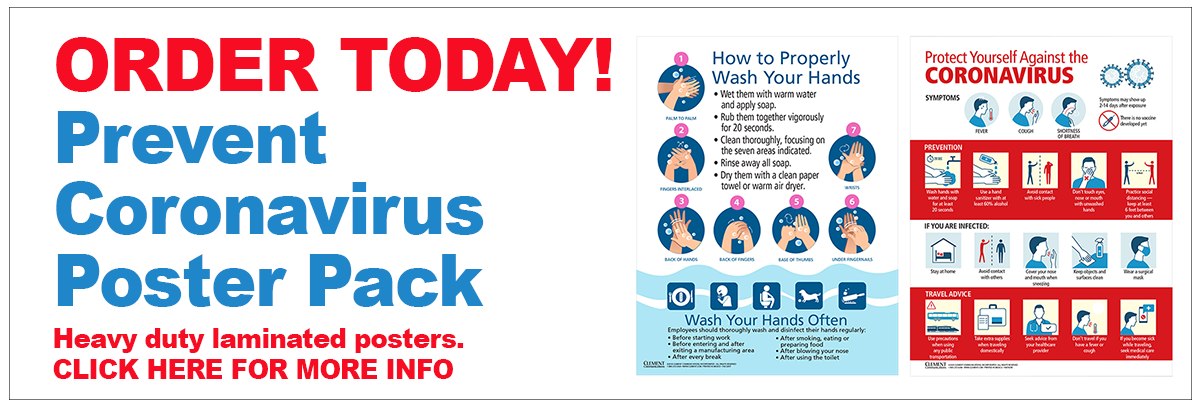Guidelines for return to work during COVID-19
As employers start to call workers into the workplace after the COVID-19 pandemic, they must do so safely, with duties to their employees and stakeholders in mind. Occupational health and safety (OH&S) legislation requires employers to protect the health and safety of individuals attending their premises.
Employers need new health and safety measures in the workplace to address the risks associated with the COVID-19 pandemic. Some government resources are provided below. While all levels of governments and public health authorities will eventually provide guidance on measures required to protect workers, in the meantime, there are many common issues employers will need to address, outlined here below.
1: Assess the COVID-19 hazard in the workplace
Provincial OH&S legislation requires that the employer conduct a hazard assessment for COVID-19 transmission in the workplace. Depending on the size of the workplace, the employer may have a duty to consult health and safety representatives or a joint health and safety committees.
To identifying hazards and developing measures to control exposure, workers compensation boards suggest that employers conduct a walk-through of the workplace to identify specific conditions or tasks that may increase the risk of exposure of employees to COVID-19.
2: Develop controls to reduce the hazard
While effective controls are to entirely eliminate physical contact between employees by having employees work remotely from home, not every job or person is suited to work from home. Work from home programs will be key in reducing the spread of COVID-19, but it may not be long-term solution that can be supported by most employers (or employees for that matter). Return to work plans may entail a staggered physical return to work, ongoing assessment of the employer’s hierarchy of controls, and evolving reassessment of workplace hazards and policies.
Prior to allowing employees to physically return to the workplace, employers should consider the following controls to address the identified hazards related to COVID-19 in the workplace:
- New policies and procedures
- Physical distancing and barriers
- Use of personal protective equipment (PPE)
- Address symptomatic employees
- Properly redressing employee requests not to work
New policies and procedures
Some types of new policies and practices to consider in the workplace include the following:
- Minimize all nonessential travel to other worksites and to meet stakeholders in person.
- Cancel all non-essential activities within the workplace, including in-person meetings, and any social events.
- Minimize the entry of stakeholders to the workplace and retain the names and contact details of any stakeholders that enter the workplace securely.
- Adjust scheduling, such as start/end times and breaks to reduce the number of people using common spaces (e.g., break rooms, kitchens, and bathrooms) and elevators at the same time.
- Consider “fit for work” screening prior to entry, such as a self-assessment questionnaire for symptoms and any recent contact with infected persons or travel to high risk areas. An example of Alberta Health Service’s “fit for work” questionnaire, can be found here and the Ontario self-assessment can be found here. If temperature testing for a fever is considered, consult with a lawyer first to ensure that employees’ rights are respected.
- Train employees on all COVID-19 risk factors and protective behaviours (e.g., transmission points, equipment cleaning processes, cough etiquette, handwashing).
- Use technology to minimize interactions (e.g., computer technology to share documents and go “cashless”).
- Implement signs to ensure distance is maintained (e.g., taped arrows to indicate “one way” traffic in hallways, tape off waiting areas to prevent bottlenecks in small spaces such as washrooms, tape off areas around workstations, appliances, machines, photocopiers, etc. to indicate appropriate two-metre spacing).
- Promote good hygiene, including regular and thorough hand-washing (e.g., ensure employees have access to soap and water and put hand sanitizer dispensers in prominent places around the workplace, and place informational posters throughout the workplace).
- Arrange for regularly scheduled enhanced cleaning and disinfecting of the workplace, particularly high-contact items such as doors, handles, faucet handles, keyboards and shared equipment.
- Assess whether the risk of transmission through the air can be reduced with ventilation and filtration provided by heating, ventilating, and air-conditioning systems.
- Check with vendors, suppliers and landlords on measures they have implemented to manage COVID-19 related risks.
- Monitor to ensure that policies are being followed (e.g., via spot checks and regular audits).
- Evaluate all other policies and procedures regularly and assess whether they are achieving the desired outcome.
(CLICK HERE – See our homepage for more information about Smart Workplace – leader in providing complete safety education, awareness and prevention solutions for companies across North America)
Physical distancing and barriers
Employers may limit physical contact and minimize personal interactions as follows:
- Minimize the number of staff in the workplace by encouraging employees to work from home where possible.
- Minimize the number of staff in the workplace by staggering or rotate returns to the workplace (e.g., specify which day(s) an employee or group of employees may come to the workplace).
- Minimize the number of individuals on the premises by staggering appointments and meetings with customers or other meeting attendees.
- Limit entry and exit points on the premises and consider whether emergency evacuation plans need to be updated for changes to access points.
- Control access to elevators and areas within the workplace, including updating key cards to limit access and limiting the number of individuals per elevator.
- Rearrange workspaces and floor plans (e.g., increase separation between desks, workstations, and furniture or fixtures in common spaces such as lunchrooms, meeting rooms, waiting rooms and washrooms).
- Install physical barriers between workers or between workers and third parties (e.g., plexiglass partitions).
- Remove all communal items that cannot be easily cleaned (e.g., newspapers, magazines and candy bowls).
- Reduce or eliminate the sharing of tools and equipment (e.g., keyboards, pens and other tools) between employees, or if sharing is required, provide disinfectant solution for employees to disinfect tools and equipment between uses.
Use of personal protective equipment (PPE)
Provincial governments have advised that PPE should only be used when all other mitigation measures have been implemented (e.g., see guidance from the Government of Alberta and the Government of Ontario).
Canada’s Chief Medical Officer currently advises that a non-medical face mask be worn if an individual is unable to maintain proper physical distance from others. A non-medical mask can reduce the potential for respiratory droplets to come into contact with others or landing on surfaces. The use of a non-medical mask is primarily to protect an employee’s co-workers, not the individual wearing the mask.
If it is determined that PPE is needed, then:
- Require or encourage the use of face masks, gloves and eye protection (as needed), supplied by the employer.
- Train employees on how to use PPE correctly, including fit, use, putting it on, taking it off, maintenance, cleaning, and disposal.
- Inform employees about the limitations of PPE.
Address symptomatic employees
Address sick employees or those who suspect they have come into contact with someone diagnosed with COVID-19 with an infection prevention and control plan, including:
- Isolate and transport home any individual who begins showing symptoms at the workplace.
- Stay at home policy for any individual who tests positive for COVID-19 shortly after attending the workplace.
- Report COVID-19 transmission in the workplace to provincial health authorities where required.
- Return to work only if the employee tests negative for COVID-19 and has completed any self-isolation period mandated by public health authorities. If the employee is unable to be tested, return to the work should not occur until the employee has completed any mandated self-isolation period and is free of symptoms.
- A “fit for work” questionnaire or COVID-19 self-assessment may be required prior to returning to the workplace.
Properly redressing employee requests not to work
There are several reasons why a worker may be unwilling or unable to return to work, including the following:
- An employee may be at a greater risk of contracting COVID-19 or of having more severe complications from COVID-19 (e.g., older adults, people with weakened immune systems, and people with medical conditions including heart disease, hypertension, lung disease, diabetes and cancer). Consider:
-
- A self-disclosure policy whereby employees can disclose that they are at a higher risk (without disclosing any personal details or sensitive medical information).
- Mitigation measures (e.g., working from home) if the employer is or becomes aware that an employee is at greater risk.
- An employee may be caring for a child or sick relative due to COVID-19 (e.g., school closure or illness). If so, job protected leaves may be available, which the employer must grant and may be precluded from terminating the employee’s employment for the duration in the leave. If an employee makes such a request, the employer may consider:
-
- Mitigation measures (e.g., working from home).
- Whether the employee is eligible for paid leave in accordance with the employer’s existing contracts, policies and practices.
- An employee may be concerned about his/her own workplace safety. While employers are working on preventative measures to ensure workers are not exposed to hazardous conditions created by COVID-19, a worker has a statutory right through OH&S legislation to refuse work if s/he believes on reasonable grounds that the work constitutes a danger to his/her health and safety. OH&S legislation varies by jurisdiction, but requirements for work refusals generally include the following steps:
-
- The employee must report the hazard to the employer.
- The employer must take any necessary corrective action in a timely manner to address the hazard reported.
- An employee who believes the workplace is still unsafe can make a complaint to the OH&S authorities in his/her jurisdiction.
- OH&S officers have authority to enforce OH&S legislation, including by conducting inspections, issuing orders, issuing violation tickets and administrative penalties.
If an employee has exercised the right to refuse to unsafe work, an employer should consult with a lawyer for information about the applicable procedure in the jurisdiction. Employers should also ensure that the accommodation policies and practices address work refusal fairly and in accordance with their legal obligations pursuant to applicable human rights legislation.
(CLICK HERE – See our homepage for more information about Smart Workplace – leader in providing complete safety education, awareness and prevention solutions for companies across North America)
Additional government resources in preparing a return to work plan:
A successful return to work plan after COVID-19 can occur if it is done safely. As outlined above, considerations for employers include new policies and procedures, physical distancing and barriers, use of personal protective equipment (PPE), addressing symptomatic employees, and properly redressing employee requests not to work.
Once preventative measures are developed, they need to be implemented, monitored and re-examined. The decisions made must be reasonable and should be documented, taking into consideration governmental and public health guidance and the employer’s duty of care to its employees, in a manner consistent with the employer’s workplace health and safety policies. A rational and documented plan in place to reopen will be necessary to ensure a smooth transition back to work.

